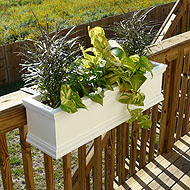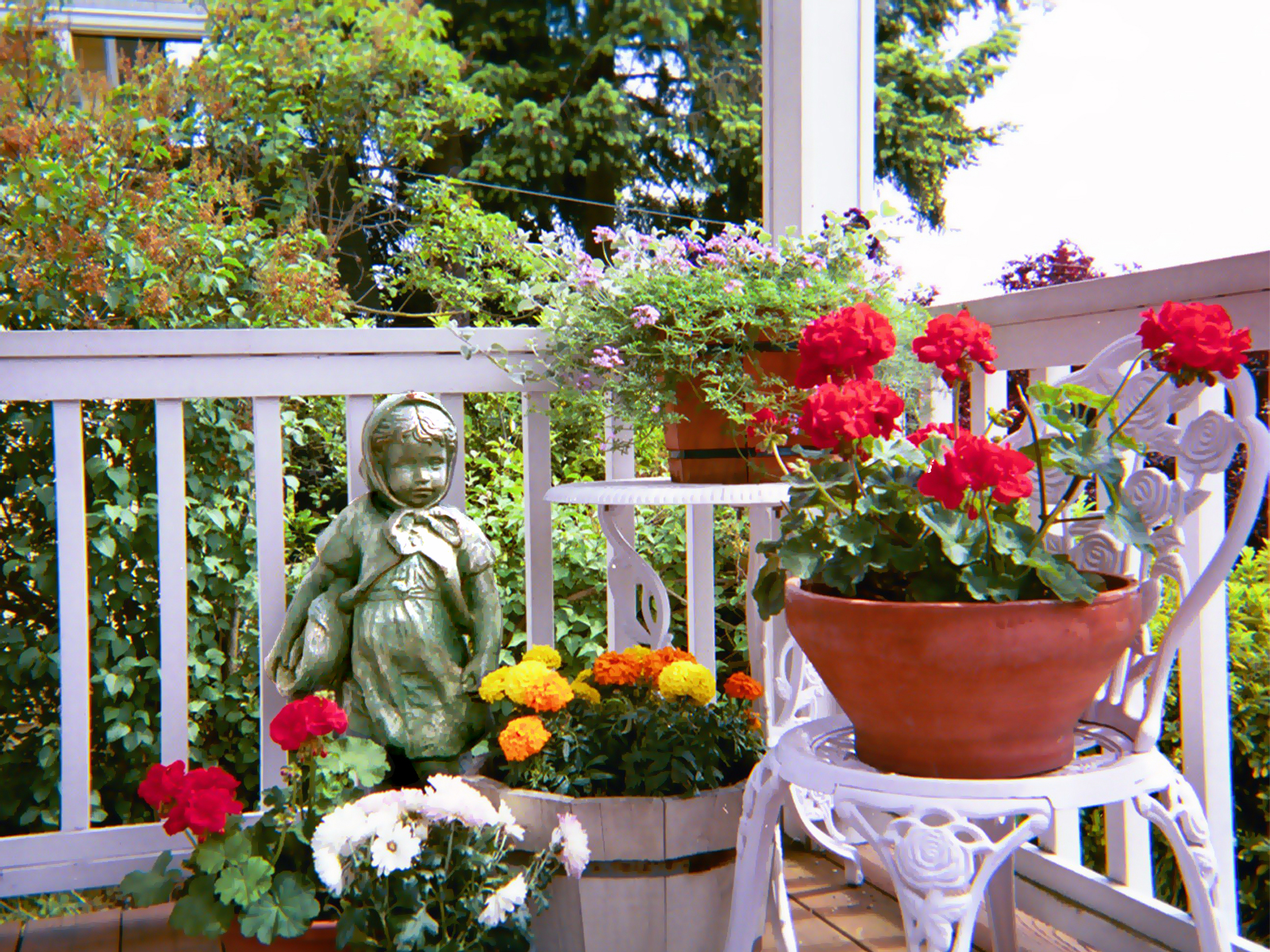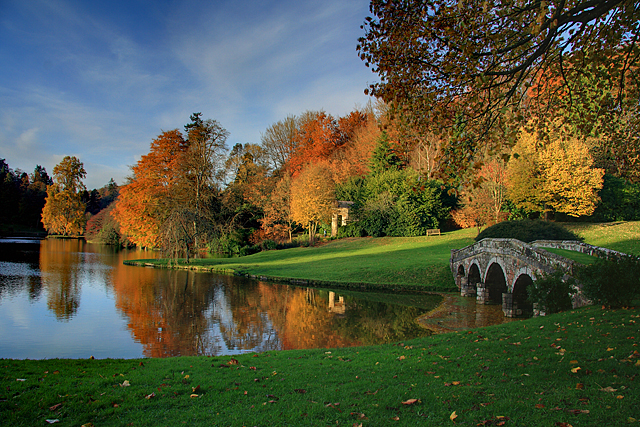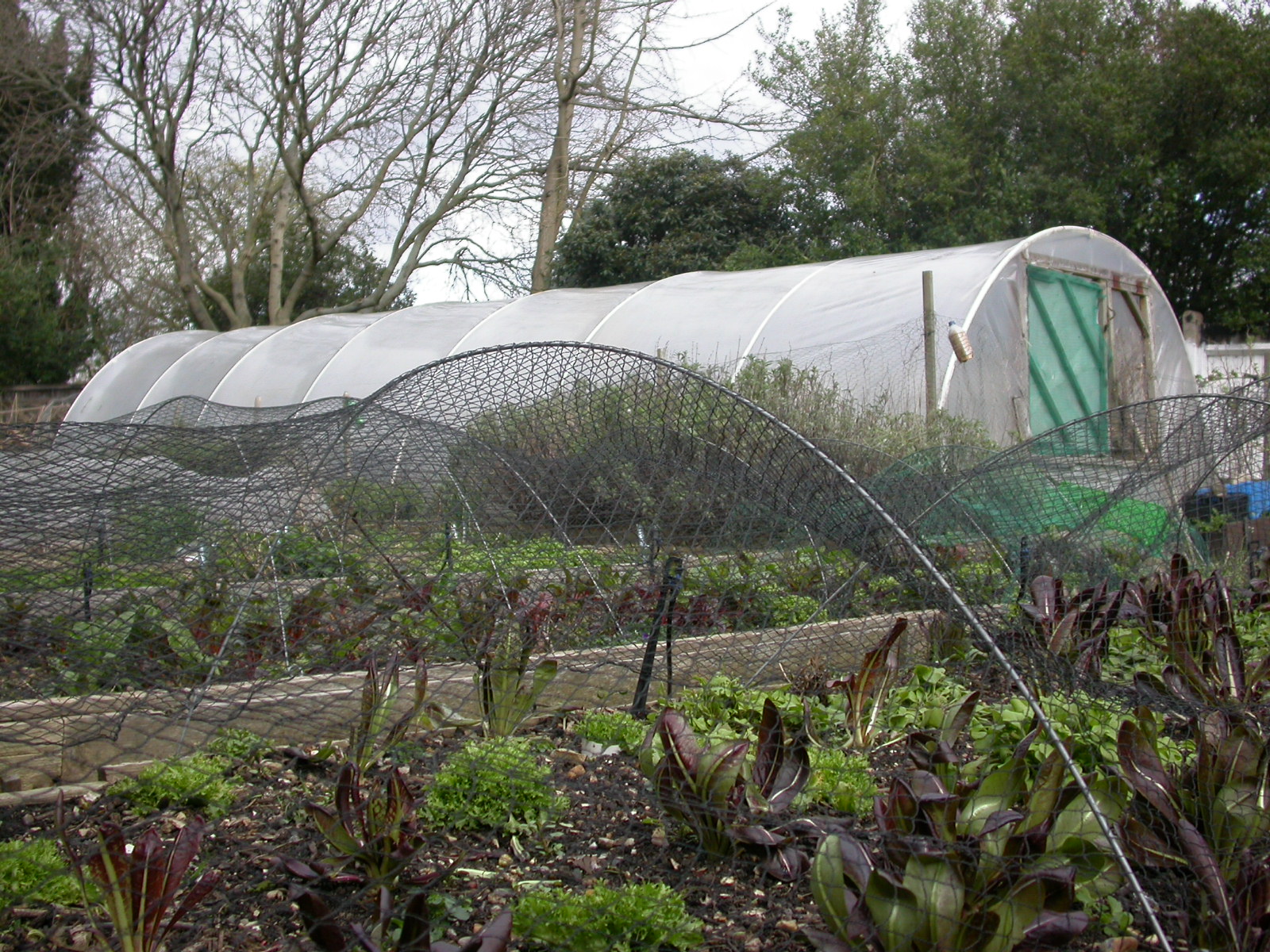|
Flower Box
A flower box is a type of container in the form of a planter or box that is usually placed outdoors and used for displaying live plants and flowers, but it may also be used for growing herbs or other edible plants. It is usually placed or affixed to an accessible location so the resident of a home may easily work with the plants in the container. A flower box may be installed under a window and supported in place by brackets on the wall below, in which case it may be called a window box. Flower boxes may also be used to line decks, patios, porches, steps, and sidewalks and they can even be hung from railings. Wood, brick, metal, fiberglass and cellular PVC can all be used in flower box construction, with wood being a classical material of choice. A typical wooden container will last 3–5 years before showing signs of rot. With painting and maintenance they can sometimes last 10–15 years. Fiberglass has the advantage of being lightweight and insect proof. PVC is a plastic tha ... [...More Info...] [...Related Items...] OR: [Wikipedia] [Google] [Baidu] |
Container Garden
Container gardening or pot gardening/farming is the practice of growing plants, including edible plants, exclusively in containers instead of planting them in the ground. A container in gardening is a small, enclosed and usually portable object used for displaying live flowers or plants. It may take the form of a pot, box, tub, basket, tin, barrel or hanging basket. Methods Pots, traditionally made of terracotta but now more commonly plastic, and window boxes are the most commonly seen. Small pots are called flowerpots. In some cases, this method of growing is used for ornamental purposes. This method is also useful in areas where the soil or climate is unsuitable for the plant or crop in question. Using a container is also generally necessary for houseplants. Limited growing space, or growing space that is paved over, can also make this option appealing to the gardener. Additionally, this method is popular for urban horticulture and urban gardening on balconies of apartment ... [...More Info...] [...Related Items...] OR: [Wikipedia] [Google] [Baidu] |
Garden Features
A garden is a planned space, usually outdoors, set aside for the cultivation, display, and enjoyment of plants and other forms of nature. The single feature identifying even the wildest wild garden is ''control''. The garden can incorporate both natural and artificial materials. Gardens often have design features including statuary, follies, pergolas, trellises, stumperies, dry creek beds, and water features such as fountains, ponds (with or without fish), waterfalls or creeks. Some gardens are for ornamental purposes only, while others also produce food crops, sometimes in separate areas, or sometimes intermixed with the ornamental plants. Food-producing gardens are distinguished from farms by their smaller scale, more labor-intensive methods, and their purpose (enjoyment of a hobby or self-sustenance rather than producing for sale, as in a market garden). Flower gardens combine plants of different heights, colors, textures, and fragrances to create interest and delight the se ... [...More Info...] [...Related Items...] OR: [Wikipedia] [Google] [Baidu] |
Types Of Garden
A wide range of garden types exist. Below is a list of examples. By country of origin *Chinese garden ** Cantonese garden ** Sichuanese garden *Dutch garden * Egyptian garden *English garden **English landscape garden *French garden **French formal garden **French landscape garden **Gardens of the French Renaissance *German garden *Greek garden *Italian garden **Italian Renaissance garden *Japanese garden ** Japanese dry garden **Japanese tea garden **Tsubo-niwa *Korean garden *Persian garden **Charbagh **Paradise garden *Spanish garden ** Andalusian Patio *United States garden **Colonial Revival garden By historical empire * Byzantine gardens *Mughal gardens *Persian gardens *Roman gardens In religion * Bahá'í gardens *Biblical garden *Islamic garden *Mary garden * Sacred garden Other * Aquascaping * Back garden * Baroque garden *Bog garden *Bosquet *Botanical gardens **Alpine **Arboretum **Palmetum *Bottle garden *Butterfly gardening *Cactus garden *Charb ... [...More Info...] [...Related Items...] OR: [Wikipedia] [Google] [Baidu] |
Garden Vases
A garden is a planned space, usually outdoors, set aside for the cultivation, display, and enjoyment of plants and other forms of nature. The single feature identifying even the wildest wild garden is ''control''. The garden can incorporate both natural and artificial materials. Gardens often have design features including statuary, follies, pergolas, trellises, stumperies, dry creek beds, and water features such as fountains, ponds (with or without fish), waterfalls or creeks. Some gardens are for ornamental purposes only, while others also produce food crops, sometimes in separate areas, or sometimes intermixed with the ornamental plants. Food-producing gardens are distinguished from farms by their smaller scale, more labor-intensive methods, and their purpose (enjoyment of a hobby or self-sustenance rather than producing for sale, as in a market garden). Flower gardens combine plants of different heights, colors, textures, and fragrances to create interest and delight the s ... [...More Info...] [...Related Items...] OR: [Wikipedia] [Google] [Baidu] |
Windowfarm
A Windowfarm is a hydroponic urban gardening system that was originally developed by Britta Riley using open-source designs. A Windowfarm is an indoor garden that allows for year-round growing in almost any window. It lets plants use natural light, the climate control of your living space, and organic “liquid soil.” About Windowfarms was a Brooklyn, NY-based social enterprise that helped city-dwellers around the world grow their own fresh food. Windowfarms made vertical indoor food gardens that optimize the conditions of windows for year-round indoor growing of greens, herbs, and small vegetables. How it works In the hydroponic system, nutrient-spiked water is pumped up from a reservoir at the base of the system and trickles down from bottle to bottle, bathing the plants’ roots along the way. Water and nutrients that are not absorbed collect in the reservoir and will be pumped through again at the next interval. Plants grown in soil have roots that extend far and wide, ... [...More Info...] [...Related Items...] OR: [Wikipedia] [Google] [Baidu] |
Window Box
A window box (sometimes called a window flower box or window box planter) is a type of flower container for live flowers or plants in the form of a box attached on or just below the sill of a window. It may also be used for growing herbs or other edible plants. Description A window box is usually placed on a window sill, or fixed to the wall immediately below it, so the owner(s) can easily access the plants in it. When installed under a window, it is usually supported by brackets on the wall below. Some materials, such as PVC or fibreglass, use a cleat mounting system from behind to attach it to the building, or it may be bolted directly to the building without the use of support brackets. Wood, brick, terracotta, metal, fibre glass, vinyl, and cellular PVC may all be used in window box construction. A typical wooden window box lasts 3–5 years before showing deterioration, though with painting and maintenance can last 10–15 years. Window boxes are usually accessed from i ... [...More Info...] [...Related Items...] OR: [Wikipedia] [Google] [Baidu] |
List Of Gardening Topics
This is an alphabetical index of articles related to gardening. A Aeroponics - African Violet Society of America - Akadama - Alkali soil - Allotment - Alpine garden - Alpine plant - ''Amateur Gardening'' - Andalusian patio - Annual plant - Aquaponics - Aquascaping - Aquatic plant - Aquatic weed harvester - Arboretum - Arboriculture - Artificial turf - Artificial waterfall - Atomic gardening - Auckland Flower Show - Australian Organic Farming and Gardening Society - Avenue - Averruncator - Award of Garden Merit - Axe B Backcrossing - Back garden - Bāgh - Bare root - Baroque garden - Basal shoot - ''BBC Gardeners' World'' - Bedding (horticulture) - Belvedere - Beneficial insect - Beneficial weed - Berry-picking rake - Biblical garden - Bibliography of hedges and topiary - Biennial bearing - Biennial plant - Biofertilizer - Bioherbicide - Biological pest control - Biopesticide - Birth flower - Bitter pit - Blackheart - Black rot - Blanching - Bletting - Blight - Blossom ... [...More Info...] [...Related Items...] OR: [Wikipedia] [Google] [Baidu] |
Urban Horticulture
Urban horticulture is the science and study of the growing plants in an urban environment. It focuses on the functional use of horticulture so as to maintain and improve the surrounding urban area. Urban horticulture has seen an increase in attention with the global trend of urbanization and works to study the harvest, aesthetic, architectural, recreational and psychological purposes and effects of plants in urban environments. History Horticulture and the integration of nature into human civilization has been a major part in the establishment of cities. During neolithic revolution, cities would often be built with market gardens and farms as their trading centers. Studies in urban horticulture rapidly increased with the major growth of cities during the industrial revolution. These insights led to the field being dispersed to farmers in the hinterlands. For centuries, the built environment such as homes, public buildings, etc. were integrated with cultivation in the form of ... [...More Info...] [...Related Items...] OR: [Wikipedia] [Google] [Baidu] |
Container (flowers)
Container gardening or pot gardening/farming is the practice of growing plants, including edible plants, exclusively in containers instead of planting them in the ground. A container in gardening is a small, enclosed and usually portable object used for displaying live flowers or plants. It may take the form of a pot, box, tub, basket, tin, barrel or hanging basket. Methods Pots, traditionally made of terracotta but now more commonly plastic, and window boxes are the most commonly seen. Small pots are called flowerpots. In some cases, this method of growing is used for ornamental purposes. This method is also useful in areas where the soil or climate is unsuitable for the plant or crop in question. Using a container is also generally necessary for houseplants. Limited growing space, or growing space that is paved over, can also make this option appealing to the gardener. Additionally, this method is popular for urban horticulture and urban gardening on balconies of apartment ... [...More Info...] [...Related Items...] OR: [Wikipedia] [Google] [Baidu] |
Flowerpot
A flowerpot, planter, planterette or plant pot, is a container in which flowers and other plants are cultivated and displayed. Historically, and still to a significant extent today, they are made from plain terracotta with no ceramic glaze, with a round shape, tapering inwards. Flowerpots are now often also made from plastic, metal, wood, stone, or sometimes biodegradable material. An example of biodegradable pots are ones made of heavy brown paper, cardboard, or peat moss in which young plants for transplanting are grown. For seedling starting in commercial greenhouses or polytunnels, pots usually take the form of trays with cells, each cell acting as one small pot. These trays are often called flats. There are usually holes in the bottom of pots, to allow excess water to flow out, sometimes to a saucer that is placed under the flowerpot. The plant can use this water with its roots, as needed. Recently, some flowerpots have been made with an automatic watering system, usin ... [...More Info...] [...Related Items...] OR: [Wikipedia] [Google] [Baidu] |
Martial
Marcus Valerius Martialis (known in English as Martial ; March, between 38 and 41 AD – between 102 and 104 AD) was a Roman poet from Hispania (modern Spain) best known for his twelve books of ''Epigrams'', published in Rome between AD 86 and 103, during the reigns of the emperors Domitian, Nerva and Trajan. In these short, witty poems he cheerfully satirises city life and the scandalous activities of his acquaintances, and romanticises his provincial upbringing. He wrote a total of 1,561 epigrams, of which 1,235 are in elegiac couplets. Martial has been called the greatest Latin epigrammatist, and is considered the creator of the modern epigram. Early life Knowledge of his origins and early life are derived almost entirely from his works, which can be more or less dated according to the well-known events to which they refer. In Book X of his ''Epigrams'', composed between 95 and 98, he mentions celebrating his fifty-seventh birthday; hence he was born during March 38, 39, ... [...More Info...] [...Related Items...] OR: [Wikipedia] [Google] [Baidu] |




_@_MakerFaire.jpg)


.jpg)

